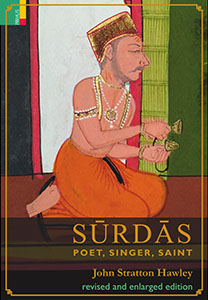
Surdas: Poet, Singer, Saint (Revised and Enlarged Edition)
AUTHOR- John Stratton Hawley
| HB ₹1395 . $79.95 . ₤64.95 |
||
INFORMATION
- AUTHOR : John Stratton Hawley
- HB ISBN : 978-93-86552-65-5
- POD ISBN : 978-93-86552-66-2
- HB Year : 2017, POD Year : 2018
- Extent : 368 pp.
- Discount available on checkout
- Usually dispatched within 3 to 5 working days.
INFORMATION
- AUTHOR – John Stratton Hawley
- ISBN – 978-93-86552-65-5
- Year – 2018
- Extent: 400 + 40 coloured illustrations
- 10% discount + free shipping
- Usually dispatched within 3 to 5 working days.
For decades Surdas has been Jack Hawley’s ideal poet. But not the Surdas we all think we know — the poet of Krishna’s childhood, the disciple of Vallabhacarya. Rather, Hawley focuses on a Surdas who emerges from the early manuscripts where his poems were first collected. They reveal quite another Sur: a poet of extraordinary range, a man who never abandoned his sense of personal struggle, a saint devoted to singing.
Was this Surdas blind? Probably not. Did he take initiation from Vallabha? No. Who was he, then? Proceeding theme by theme, Hawley paints a very different portrait.
In the final chapter, Hawley shows us how actual portraits of Surdas appeared in the course of the seventeenth century. By roughly 1700, some 150 illustrations of Sur’s poems had been painted in Udaipur, and in each one we see the poet himself — far more often than any of his bhakti peers. Hawley argues that the legend of Sur’s blindness helps explain this efflorescence. In a new 100-page chapter written especially for this revised edition, we have a chance to see how this visual tradition developed — and to see it in glorious colour.
The Author
John Stratton Hawley, informally Jack, is Claire Tow Professor of Religion at Barnard College, Columbia University.
For decades Surdas has been Jack Hawley’s ideal poet. But not the Surdas we all think we know — the poet of Krishna’s childhood, the disciple of Vallabhacarya. Rather, Hawley focuses on a Surdas who emerges from the early manuscripts where his poems were first collected. They reveal quite another Sur: a poet of extraordinary range, a man who never abandoned his sense of personal struggle, a saint devoted to singing.
Was this Surdas blind? Probably not. Did he take initiation from Vallabha? No. Who was he, then? Proceeding theme by theme, Hawley paints a very different portrait.
In the final chapter, Hawley shows us how actual portraits of Surdas appeared in the course of the seventeenth century. By roughly 1700, some 150 illustrations of Sur’s poems had been painted in Udaipur, and in each one we see the poet himself — far more often than any of his bhakti peers. Hawley argues that the legend of Sur’s blindness helps explain this efflorescence. In a new 100-page chapter written especially for this revised edition, we have a chance to see how this visual tradition developed — and to see it in glorious colour.
The Author
John Stratton Hawley, informally Jack, is Claire Tow Professor of Religion at Barnard College, Columbia University.
Table of Contents
Table of Contents
| List Of Illustrations | Ix-X |
| Preface | Xi-Xviii |
| Acknowledgements | Xix-Xx |
| Transliteration And Pronunciation | Xxi-Xxiii |
| The Blind Poet | 3-38 |
| The Growth Of The Sursagar | 39-72 |
| Sur’s Radha: A Case Study | 73-106 |
| Viraha: Separation And Simple Religion | 107-138 |
| Sant And Sinner | 139-184 |
| Song As Salvation | 185-204 |
| An Afterlife In Art | 205-304 |
| Notes On The Translations | 305-334 |
| Glossary | 337-344 |
| Bibliography | 345-361 |
| Index | 367-375 |




